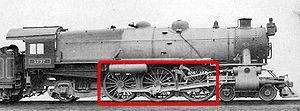
Back Рухальныя колавыя пары Byelorussian Hnací náprava Czech Kuppelradsatz German Mova rado Esperanto Rueda motriz Spanish Roue motrice French 駆動輪 Japanese 구동 바퀴 Korean Oś napędowa Polish Движущие колёсные пары Russian


On a steam locomotive, a driving wheel is a powered wheel which is driven by the locomotive's pistons (or turbine, in the case of a steam turbine locomotive).[1] On a conventional, non-articulated locomotive, the driving wheels are all coupled together with side rods (also known as coupling rods); normally one pair is directly driven by the main rod (or connecting rod) which is connected to the end of the piston rod; power is transmitted to the others through the side rods.[2][3][4]
On diesel and electric locomotives, the driving wheels may be directly driven by the traction motors. Coupling rods are not usually used, and it is quite common for each axle to have its own motor. Jackshaft drive and coupling rods were used in the past[5][6] (e.g. in the Swiss Crocodile locomotive[7]) but their use is now confined to shunter locomotives.
On an articulated locomotive or a duplex locomotive, driving wheels are grouped into sets with wheels within each set linked together.
- ^ Fowler, George L. (1909). Locomotive Dictionary (1909 ed.). New York: The Railroad Age Gazette. p. 37 – via Google Books.
- ^ Forney, Matthias N. (1879). Catechism of the Locomotive. New York: The Railroad Gazette. p. 177 – via Google Books.
- ^ Rattan, S.S. (2006) [1993]. Theory of Machines (second ed.). New Delhi, India: The McGraw-Hill Publishing Company Ltd. p. 560. ISBN 0-07-059120-2 – via Google Books.
- ^ Profillidis, V.A. (2006). Railway Management and Engineering (third ed.). Aldershot, England, and Burlington, VT, USA: Ashgate Publishing. p. 382. ISBN 978-0-7546-4854-3 – via Google Books.
- ^ Ransome-Wallis 2001, pp. 175–176.
- ^ Franco, Prof. I.; Labryn, P. (11 November 2013). Internal-Combustion Locomotives and Motor Coaches. Springer. p. 52. ISBN 978-94-017-5765-2 – via Google Books.
- ^ Steimel, Andreas (2008). Electric Traction – Motive Power and Energy Supply. Munich: Oldenbourg Industrieverlag GmbH. p. 38. ISBN 978-3-8356-3132-8 – via Google Books.